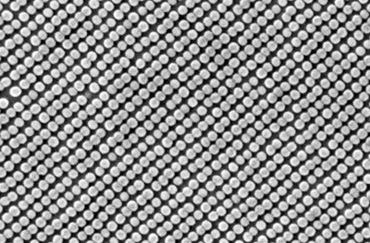HGST (formerly Hitachi Global Storage Technologies and now a Western Digital company, NASDAQ: WDC) is leading the disk drive industry to the forefront in nanolithography, long the exclusive purview of semiconductor manufacturers, by creating and replicating minute features that will allow the doubling of hard disk drive (HDD) density in future disk drives.
HGST Labs announced today they have combined two innovative nanotechnologies -- self-assembling molecules and nanoimprinting -- to create large areas of dense patterns of magnetic islands only 10 billionths of a meter (10 nanometers) wide. These features are only about 50 atoms wide and some 100,000 times thinner than a human hair.
“As creators of the original hard disk drive, we are proud to continue our heritage of innovation with today’s nanotechnology advance,” said Currie Munce, vice president, HGST Research. “The emerging techniques of self-assembling molecules and nanoimprinting utilized at the HGST Labs will have an enormous impact on nanoscale manufacturing, enabling bit-patterned media to become a cost-effective means of increasing data densities in magnetic hard disk drives before the end of the decade.”

HGST is becoming a leading player in nanolithography. Today’s announcement represents a creative answer to the problems with photolithography and has grown out of the storage industry’s unique technical and strict cost targets. HGST nanolithography achievements come at a critical juncture for storage drives as cloud computing, social networking and mobility create an ever increasing amount of content that must be stored, managed and accessed efficiently.
The Nanolithography Process
Tom Albrecht, HGST Fellow, spoke at this week’s SPIE Advanced Lithography 2013 conference in San Jose, CA., regarding HGST’s nanolithography discoveries. He described the patent-pending work his team did in partnership with Austin, Texas-based Molecular Imprints Inc., to make dense patterns of magnetic islands in about 100,000 circular tracks required for disk drives.
Self-assembling molecules use hybrid polymers, called block copolymers, composed of segments that repel each other. Coated as a thin film on a properly prepared surface, the segments line up into perfect rows. The size of the polymer segments determines the row spacing. After polymer patterns are created, a chip-industry process called line doubling makes the tiny features even smaller, creating two separate lines where one existed before. The patterns are then converted into templates for nanoimprinting, a precision stamping process that transfers the nanometer-scale pattern onto a chip or disk substrate. A key challenge proved to be preparing the original surface so the block copolymers form their patterns in the radial and circular paths necessary for rotating disk storage. HGST is the first to combine self-assembling molecules, line doubling and nanoimprinting to make rectangular features as small as 10 nanometers in such a circular arrangement.
Today’s announcement provides a roadmap for how to cost effectively create the magnetic islands at densities much beyond today’s capabilities. The bit density of HGST’s 10-nanometer pattern is double that of today’s disk drives and lab tests show excellent initial read/write and data retention. When extended to an entire disk, the nanoimprinting process is expected to create more than a trillion discrete magnetic islands.
“We made our ultra-small features without using any conventional photolithography,” Albrecht said. “With the proper chemistry and surface preparations, we believe this work is extendible to ever-smaller dimensions.”
Because self-assembling molecules create repetitive patterns, researchers expect they will be best suited to making bit-patterned magnetic media for disk drives, uniformly spaced regions for computer memories, various wiring contacts and other periodic features of other types of semiconductor chips. Nanoimprinting and self assembling molecules are also most easily introduced in defect-tolerant applications such as disk drives or memory, even as the industry works to perfect the technologies for more demanding applications.
About HGST
HGST (formerly known as Hitachi Global Storage Technologies or Hitachi GST), a Western Digital company (NASDAQ: WDC), develops advanced hard disk drives, enterprise-class solid state drives, innovative external storage solutions and services used to store, preserve and manage the world’s most valued data. Founded by the pioneers of hard drives, HGST provides high-value storage for a broad range of market segments, including Enterprise, Desktop, Mobile Computing, Consumer Electronics and Personal Storage. HGST was established in 2003 and maintains its U.S. headquarters in San Jose, California. For more information, please visit the company’s website at http://www.hgst.com.
Source: HGST
